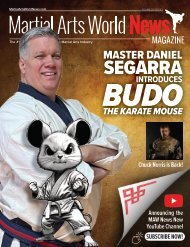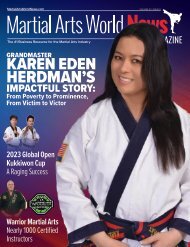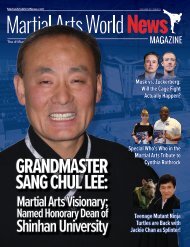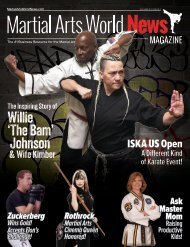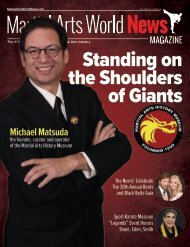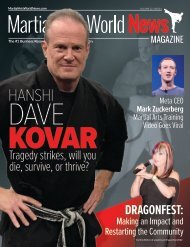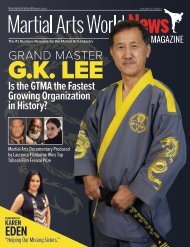Martial Arts World News Magazine - Volume 22 | Special Edition
The #1 Business Resource for the Martial Arts Industry
The #1 Business Resource for the Martial Arts Industry
You also want an ePaper? Increase the reach of your titles
YUMPU automatically turns print PDFs into web optimized ePapers that Google loves.
INDUSTRY INSIGHTS<br />
Two Sides of the Same <strong>Martial</strong> <strong>Arts</strong> Coin:<br />
Tradition and Progress<br />
Many practitioners as well as Instructors take pride in the phrase<br />
“Traditional <strong>Martial</strong> <strong>Arts</strong>” as the kind of training and style they<br />
practice and teach. Others are just as eager to express that they<br />
“absorb what is useful” in lieu of wasting their time with what might<br />
be referred to as “The Classical Mess.” The thought being presented<br />
here is that these are two sides of the martial arts coin.<br />
Can we at least agree that today’s tradition at some point was<br />
yesterday’s progress. There is no written or unwritten standard for how<br />
long something must be done before it becomes a tradition, is there?<br />
It” more than likely, and demonstrated in history, that today’s “Traditional<br />
<strong>Martial</strong> <strong>Arts</strong>” were considered heterodox in the name of progress.<br />
Aikido has in its foundation many styles of Jujitsu and was considered<br />
an innovation when Morihei Ueshiba created it, but today it<br />
receives the traditional label. Jeet Kune Do on the other hand met<br />
much opposition initially even though its foundation is in classical<br />
Wing Chun and incorporated techniques from other Traditional<br />
<strong>Martial</strong> <strong>Arts</strong>. Surely the practitioners of each are practicing martial<br />
arts in the traditional sense (sarcasm intended).<br />
Today, we have Mixed <strong>Martial</strong> <strong>Arts</strong> which most systems are<br />
based in Jujitsu and includes tactics from other styles that also fall<br />
under the so-called Traditional <strong>Martial</strong> <strong>Arts</strong> Umbrella. Finding the<br />
balance is the key between tradition and progress not division. Many<br />
schools today might call themselves sharing Traditional <strong>Martial</strong> <strong>Arts</strong><br />
but have classes that include TaeKwondo, Tai Chi, and Grappling.<br />
Think about it. Did it become Tradition to have Korean, Chinese,<br />
Japanese or Brazilian styles in one Dojang, Kwoon, Dojo or School?<br />
International TaeKwonDo Day –<br />
September 4, 20<strong>22</strong><br />
Annually, September 4 is celebrated as International Taekwondo<br />
Day. The international community observes this<br />
day to commemorate Taekwondo becoming a medal sport in the<br />
Olympics. In 2006, the first International Taekwondo Day was held<br />
in South Korea after being initiated by the ruling body of the style,<br />
formerly known as the <strong>World</strong> Taekwondo Federation.<br />
As a relatively recent development, Taekwondo doesn’t<br />
have a long history, but it has had great growth as a practice<br />
throughout the world. It’s popularity is proven just in having this<br />
kind of celebration when so many other older and well established<br />
martial arts have no such event. It was on September 4,<br />
1996 that the International Olympic Committee officially adopted<br />
Taekwondo as an Olympic competition. In the 2000 Summer<br />
Olympics in Sydney, Australia Taekwondo had it inaugural Olympic<br />
competitive debut.<br />
From the initial celebration of International Taekwondo Day<br />
in Seoul, South Korea to present times, there has been a huge<br />
spread of participants celebrating the day globally. More than 70<br />
million people practice Taekwondo throughout the world, in more<br />
than 188 other countries around the world. This is a great opportunity<br />
to promote your school with community events, media<br />
opportunities and internal promotions.<br />
Do You Have Energizer Bunny<br />
Syndrome?<br />
As a martial artist, you probably pride yourself on being<br />
tireless and always full of energy. Like the Energizer<br />
Bunny for the Energizer<br />
Battery, try to “keep<br />
going and going and<br />
going”. But just like that<br />
battery runs out of juice,<br />
you will too, if you keep<br />
burning the candle from<br />
both ends.<br />
You surely tell your<br />
students, daily exercise,<br />
proper eating, and quality<br />
rest is necessary for being<br />
your best. With this in mind<br />
be sure to manage YOUR<br />
energy and rest well to<br />
optimize your performance<br />
and care for yourself. Your<br />
students deserve to have<br />
you at your ‘best’, not a<br />
drained shell of yourself!<br />
14 MARTIAL ARTS WORLD NEWS VOLUME <strong>22</strong> | SPECIAL EDITION<br />
Photography by Artur Didyk (top left) and Prostock-Studio (bottom right)




